This was published 1 year ago
It’s possible to fly just three hours and feel like you’re in France
By Keith Austin
Who doesn’t love France? The wine, the sheer variety of fromages, patisseries, croissants and l’arôme of freshly baked baguettes. The only problem? It’s all in France, 15,000 kilometres away at the best of times.
Or not. For France, or at least a version of it, is closer than I thought (1210 kilometres or thereabouts).
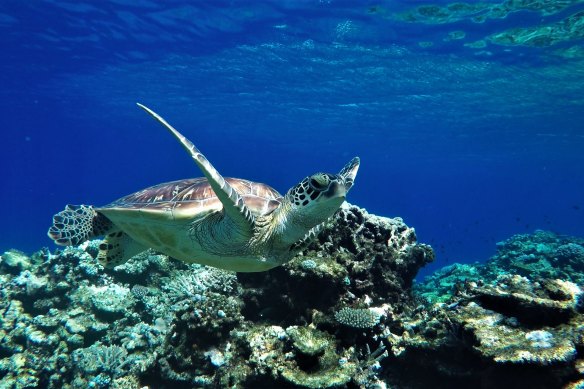
Snorkelling the clear waters off New Caledonia.
Look, I knew Nouvelle-Calédonie was a French outpost (a “special collectivity”, to give it its official title) but I imagined it would be a South Pacific nation with a thin veneer of essence Française – a saucisse casing filled with local Kanaks and Polynesians, if you will.
This is not the case, despite the four-piece band in traditional dress which greets us at the airport on arrival. Overall, it’s very French, with lots of French nationals gadding about clutching bottles of bordeaux and provocatively torturing the English language in that saucy way of theirs.
The French President, Emmanuel Macron, was in New Caledonia recently to talk about the last referendum on independence (in December 2021), which the island’s indigenous, largely pro-independence Kanaks, boycotted. As a result, 97 per cent of those who did vote, voted to remain part of France.
Under something called the Noumea Accord, signed in 1998, France promised to grant the original inhabitants of Nouvelle Calédonie a degree of political autonomy (though France would continue to control military and foreign policy, immigration, police and currency) until such time as the country voted for independence.
In the first referendum, held in November 2018, 56.4 per cent of voters rejected independence. In 2020 that changed to 57 per cent.
Local zoreilles, the name given to New Caledonia residents born in France proper, are solidly behind rejecting independence, arguing that a solo, cash-strapped New Caledonia (French financial support represents more than 15 per cent of the gross domestic product here) would find itself easy prey to Chinese economic influence in the region.
Hopefully, if the indigenous people do succeed in gaining independence, they won’t do to the zoreilles what their ancestors did to the crew of the American ship, the Cutter, in 1849. They ate them.
Regardless of what the future holds, tourism to this smidgen of France in the South Pacific is much underdone (unlike the crew of the Cutter), peaking at just 130,000 visitors a year in 2019 before falling off a cliff when the pandemic hit.
From January to June 2023, New Caledonia welcomed a record number of tourists with 54,184 arrivals (by plane), an increase of 2.3 per cent compared with the first half of 2019. This includes a 29 per cent increase in Australians, a 33 per cent increase in New Zealanders, and a 12 per cent increase in mainland French.
Just under three hours from Sydney, this tiny archipelago has a total land area of 18,500 square kilometres and a population of about 300,000. Most visitors take in the capital, Noumea, and the famous Isle of Pines (a popular cruise ship stop) but there’s much more to see if you take a bit of time to explore.
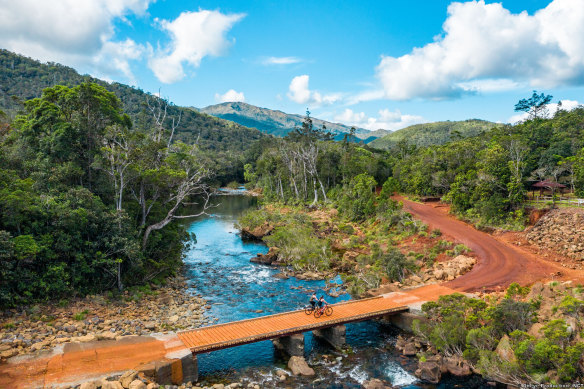
Blue River Park.
Take, for instance, the Blue River Provincial Park, a nature reserve where we spend a morning kayaking through a drowned forest, looking for the flightless kagu bird and taking a dip in one of the pretty rivers that thread through the area.
It’s a side of New Caledonia that few take the time and trouble to visit, even though it’s an easy 90-minute drive northeast of Noumea. Part of the Upper Yate fauna reserve, the park features shrubland, rainforest (known wonderfully and very much to the point in French as la forêt dense humide) and is one of the last areas where the kagu can be seen in its natural habitat.
Now very much a symbol of the country, there are about 700 kagu in the park, the largest single population of the species in the wild – and we are lucky enough to come across two of them during our time here.
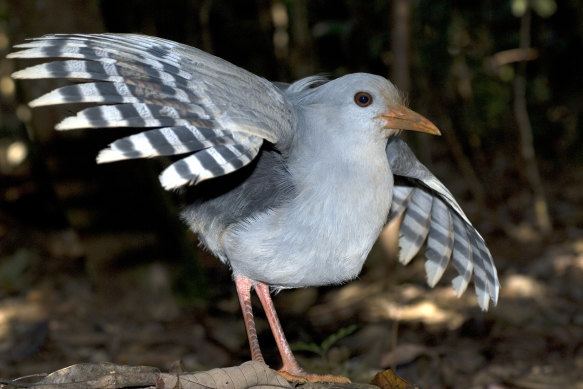
A kagu – endangered, and utterly unconcerned by human presence.
About 55 centimetres long, these are lovely, greyish-white birds with red legs, like little herons, and are either very brave or very stupid for they are utterly unconcerned by our presence. Given that Europeans once considered them a delicacy (kagu à l’orange?) or took them as pets, you’d think they might be a little more circumspect, but no, our two strolled around like it was a bank holiday weekend at Westfield.
They are, oddly enough, threatened with extinction.
The drowned forest became drowned in 1958 after a dam was built and the valley flooded. Today, the hundreds of trees that remain are unnervingly bleached stumps poking up out of the calm, shallow waters of man-made Lake de Yate. Kayaking around these gnarled and ghostly gums is serene, relaxing and ever so slightly surreal.
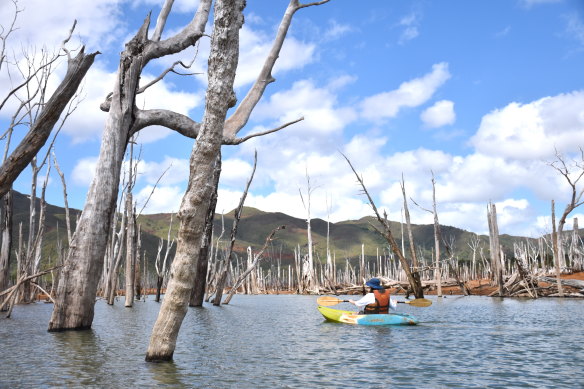
Kayaking Lake de Yate amid its drowned forest.
There’s also, at the start of a short circular hike in the dense and humide forest, a 40-metre giant kauri pine, which is more than 1000 years old, measures 2.7 metres around the base and has a crown 35 metres in diameter. There’s no hugging it but you might tip your hat in respect.
Snorkelling is another pastime that can get you out and about beyond Noumea. After all, New Caledonia’s lagoon harbours the longest continuous barrier reef in the world at 1500 kilometres. This, in turn, encloses a lagoon of 24,000 square kilometres.
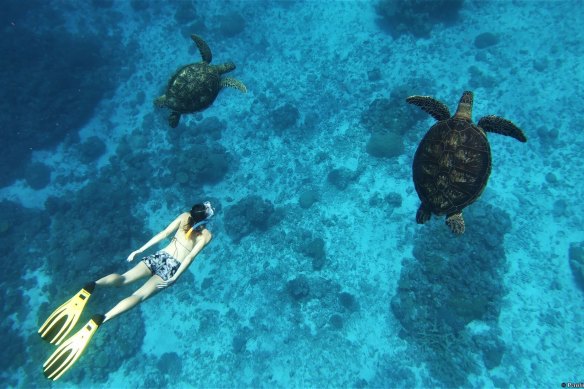
Snorkelling as it should be done.
From our base at the luxurious Sheraton New Caledonia Deva Spa & Golf Resort midway up the west coast of the main island, we take a boat out to Ile Verte, a small island in this UNESCO World Heritage Site.
Green Island is a special nature reserve of a mere 28 square kilometres (and that includes the surrounding reef flats). With most of the island off limits to protect nesting turtles, this leaves just a small stretch of beach and a stony headland on which to wallow. Luckily, we are the only group here.
It is, however, not the most auspicious of days as there is a strong rip running from right to left off the beach, right over the coral. It’s amazing to be able to just walk out to this beautifully colourful underwater landscape but the rip is so strong that everything looks as if it’s going backwards as I’m swept away to emerge, exhausted after the fourth attempt, at the far end of the beach.
There are fish galore under there, but they all look slightly bug-eyed and surprised. This is because they’re thinking, “How does that huge white slug manage to swim that fast? And backwards?”
The writer travelled as a guest of New Caledonia Tourism and Aircalin. See newcaledonia.travel/au
THE DETAILS
FLY
Aircalin operates daily flights from Sydney and Brisbane to Noumea in codeshare with Qantas. From December 8, there will be three flights a week from Melbourne to Noumea, operated by Aircalin only. See aircalin.com.au
TOUR
Toutazimut runs eco tours to the Blue River Park, including kayaking the drowned forest, and elsewhere across New Caledonia.
See toutazimut.nc
STAY
We stayed at the Le Meridien Noumea resort and spa (from $410) and the Sheraton New Caledonia Deva spa and golf resort (from $280); both are Marriott Bonvoy hotels. While staying at the Sheraton, take the time to climb the small hill behind the resort for views of the countryside and ocean. Excursions to Green Island can be booked through the hotel’s concierge.
See marriott.com
Sign up for the Traveller Deals newsletter
Get exclusive travel deals delivered straight to your inbox. Sign up now.